In our May Customer Success Tip, I mentioned the idea of having multiple views of a single value model depending on the audience or phase of the sales process you might be in. As promised, this post kicks off our 3 part series on the layers of a Value Proposition with the “Case Study View”.
What’s the goal?
As with any sales presentation – you want to close the deal, but in this case, you’re just beginning the sales process. This is phase 1. You’ve got an interested prospect that wants to learn more about what you can do for them, but you’re not even sure if they’re the person you should be talking to. The goal of the Case Study View is qualification, engagement, and to schedule the next call.
The Presentation
For the Case Study View it’s important to keep things simple and straightforward. I’ll use a fictitious example below to review some best practices, but remember, the ability to customize, reorder, redesign, and add slides is always available in LeveragePoint; your View will be unique to your company.
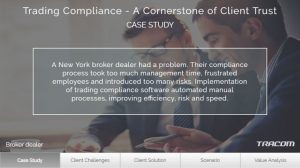 This example begins with a simple problem statement – as most good case studies do. Define the top issues that a typical customer had and how your solution helped to solve those issues.
This example begins with a simple problem statement – as most good case studies do. Define the top issues that a typical customer had and how your solution helped to solve those issues.
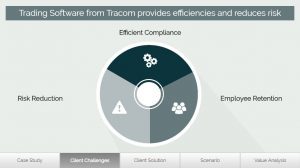 Moving to the next slide in the presentation, we begin to make specific claims about our solution. These specific claims may or may not be challenges that the current prospect is faced with; this slide will generate conversation about what is most important to the prospect on the line.
Moving to the next slide in the presentation, we begin to make specific claims about our solution. These specific claims may or may not be challenges that the current prospect is faced with; this slide will generate conversation about what is most important to the prospect on the line.
If you’re familiar with LeveragePoint terminology, we refer to these claims as Value Drivers. Note on this slide, however, that we are not associating any dollar amounts with the Value Drivers just yet. Right now, we’re simply engaging in conversation around what the customer challenges are.
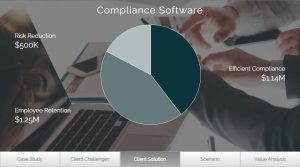 The third slide in the Case Study View is where we associate dollar values with each claim. Here, we stitch together the typical customer scenario with the claims we’re making.
The third slide in the Case Study View is where we associate dollar values with each claim. Here, we stitch together the typical customer scenario with the claims we’re making.
On this slide the conversation moves a bit more towards quantification, but never gets into pricing. We’re still qualifying the prospect at this point. The goal is to learn as much as we can about their specific needs while putting a dollar value on the benefits of our solution.
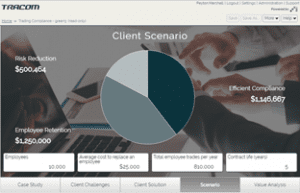 The Scenario slide is where we really begin to customize the conversation around the prospect’s situation.
The Scenario slide is where we really begin to customize the conversation around the prospect’s situation.
Note the Key Variables that have been introduced here, displayed in the four white boxes at the bottom of the slide. These variables are in line with the case study and might represent “typical” data. Maybe the prospect you’re talking to has many more employees, or their cost to replace an employee is much higher. This is the slide where you can make adjustments to the model so that it fits the prospect you’re talking to. This highly engaging technique allows the prospect to see the impact of your solution in real time, furthering the conversation and shedding light on exactly how your solution will be valuable to them.
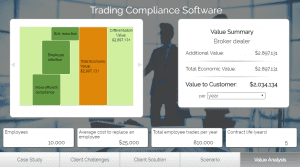 In the final slide, we present the familiar summary information that you’ve likely seen in LeveragePoint before. At this point in the conversation, the prospect should be very engaged, and may want to take a bit of a dive into more quantitative analysis. It really is up to the salesperson to guide the conversation if it needs to go there, and perhaps use that carrot as a springboard to a follow up meeting. Either way, at the end of the conversation, it will be imperative to get the next meeting scheduled with the right decision makers in the room.
In the final slide, we present the familiar summary information that you’ve likely seen in LeveragePoint before. At this point in the conversation, the prospect should be very engaged, and may want to take a bit of a dive into more quantitative analysis. It really is up to the salesperson to guide the conversation if it needs to go there, and perhaps use that carrot as a springboard to a follow up meeting. Either way, at the end of the conversation, it will be imperative to get the next meeting scheduled with the right decision makers in the room.
The Case Study View is a valuable first step in a three step, layered value selling conversation. It enables the sales rep to present a high level view of the proposed solution, tease out the correct value drivers and make sure they resonate with the prospect, and then tailor the conversation around the prospect’s specific needs. It starts the sales process with engaging, dynamic information that will drive further conversations with the correct decision makers.
If you’re interested in creating a case study of your own based on your current content, please don’t hesitate to reach out to us. We’ll be happy to get you started crafting a brand new story.

